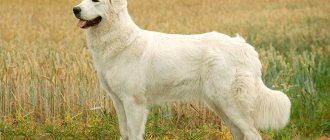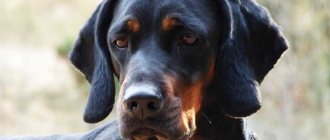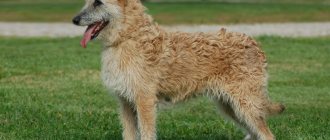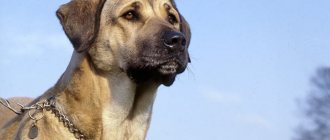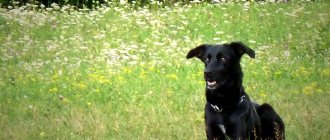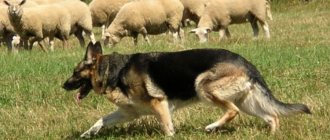Polish Lowland Sheepdog is a smart, funny guy with a high work ethic and no lack of energy. The dogs are popular in Poland as guard dogs and shepherds.
A lively and self-confident representative of the breed needs a devoted owner. His thick, shaggy double coat requires daily brushing, and his stubborn temperament tests the will of new trainers.
Developing your skills as a reward-based trainer will help you and your Polish Lowland Shepherd work together in an orderly manner. However, if you give him the necessary training, exercise and care, he will become a fantastic companion and reliable worker for you.
- Breed overview
- Characteristics of the Polish Lowland Sheepdog
- History of the Polish Lowland Sheepdog
- Caring for the Polish Lowland Shepherd
- Common Health Problems of the Polish Lowland Shepherd
- How and what to feed the Polish Lowland Shepherd Pros
- Minuses
- Similar breeds:
Description
The description of the Polish Lowland Shepherd breed is as follows:
- The animal is large, but lightweight. With a height of 45-55 centimeters, males weigh about 22 kilograms. Bitches reach 46 centimeters, and their weight varies from 12 to 18 kilograms. It would seem that the dog looks like a dystrophic person. But that's not true.
- The head is large, the forehead is wide.
- Eyes are dark in color. Wide set.
- Very pronounced nose and jaw.
- The body is long but squat.
- Limbs are short and straight.
- The tail is missing.
- The coat is dense and long. The animal has a thick undercoat.
- The color is varied. Acceptable colors are brown, black, beige, black and white, gray and white and pure gray.
It is important to take into account that the dog is registered with the FCI as a herding dog.
History of the Polish Lowland Sheepdog
The breed originated in the region that eventually became Poland. The theory goes that in the 1300s, the Huns and other Asian invaders entered Eastern Europe and their dogs crossed with local dogs, creating this breed. Of course, no one is 100 percent sure that this is exactly the case.
The breed's assertiveness and dedication attracted fans, and the breed was eventually crossed with Scottish Cattle Dogs to create the Bearded Collie. The Polish Kennel Club officially recognized this breed in 1959.
Positive traits
The Polish Lowland Shepherd is very self-confident. Although in the FCI it is classified as a herding dog, in Poland the dog is used for protection.
The main advantages of the animal:
- Friendliness towards the owner. At home it is not a dog, but a sofa cushion. Very affectionate, gentle and sensitive, she will gladly take part in family gatherings. He will sit next to his owner and look at him with adoration.
- Easy to train. The Polish Shepherd breed grasps everything on the fly. But you need to deal with it positively. She does not tolerate violence against herself.
- Wary of strangers. This is an excellent guard. A fly wouldn’t fly past such a thing, not that a stranger would pass by.
- Energetic. For lovers of outdoor activities, the Polish Lowland Sheepdog is perfect. She will not let her owner sit still and get bored, she will walk with him until he wins.
Characteristics of the Polish Lowland Sheepdog
| Attachment level | Average |
| Friendliness | Medium-low |
| Child Friendly | Average |
| Possibility of living with others with pets | Average |
| Exercise needs | High |
| Playfulness | Medium-high |
| Energy level | High |
| Learning ability | Medium-low |
| Intelligence | Medium-high |
| Tendency to bark | Average |
| Shedding amount | High |
Negative qualities
The dog is good to everyone, but too distrustful. However, now in more detail about its shortcomings:
- Doesn't like children. Of course, she tolerates them if necessary. But he doesn’t feel particularly reverent. The Polish Lowland Shepherd (photos are posted in the article) will not perform the duties of a four-legged nanny.
- He can't stand his own kind. When meeting other dogs, conflict is inevitable. He will use his teeth without hesitation. Moreover, the first one will provoke a fight.
- Does not tolerate cats. Why the Polish Lowland Sheepdog didn’t like these cute animals, only she knows. But the fact remains a fact. It will tear into small pieces.
- Needs labor-intensive coat care.
- This dog is in dire need of moral and physical stress. The dog is a working dog, and when it does not receive proper exercise, it begins to go crazy. Literally. Chews the leash and various objects, becomes irritable. May involve defensive behavior.
How to choose a puppy?
The Polish Shepherd is considered the most popular breed among dog breeders, but it is quite rare and is most often found in America and the Netherlands. Today, it has become possible to purchase puppies of this breed both in many nurseries in Europe and from private individuals who breed dogs. At the same time, the price of puppies can be different, it all depends on the purebred of the parents.
Since one of the most common diseases of this Shepherd breed is hip dysplasia, it is important to make sure that the puppy does not inherit it from his parents. To do this, puppy sellers must provide x-rays of the parents taken by “father and mother” at one year of age
In addition, the child’s parents must have certificates of completion of OKD obedience courses.
The mother of the babies should be of normal nutrition, look healthy and be active
When choosing a puppy, it is also important to evaluate the conditions of its maintenance and the quality of feeding. Pets should spend a lot of time outdoors and be constantly in free movement.
This will ensure the dogs develop their musculoskeletal system correctly.
Starting from 2 months of age, Polish Shepherd babies meet all breed standards, so when purchasing them you should pay attention to the body format, ear set, bite and paw strength. In addition, purebred representatives of the breed have a special puppy card and brand
It is recommended to purchase a baby exclusively from specialized nurseries if he has a personal veterinary passport, which must contain vaccination marks. As for the chip, it is only required to transport the animal to other countries.
Care
We mentioned that the Polish Shepherd (dogs of different ages are shown in the photo) requires labor-intensive care. What is the main difficulty?
In combing, of course. The pet has amazing fur. But if you don’t take care of her, the dog will turn into a dirty, matted “washcloth.” You need to brush your pet three to five times a week. During molting - daily.
Frequent washing is not required. Two or three times a year is enough. After a walk, the paws and belly must be wiped with a wet cloth.
More dog breeds
Always do your research before introducing any new animal into your life. It's a good idea to talk to both current breed owners and breed organizations, and this is especially important for breeds like the Polish Plain Shepherd, which do require a little extra training and attention.
Since this breed is relatively rare, make sure to meet several of them. Talk to owners and breeders.
Similar breeds:
It is important
Representatives of the breed are not suitable for living in an apartment. These dogs, due to their nature, will cause irreparable damage to others. What is meant? Let’s say a neighbor came in, but they didn’t have time to lock up the dog. Or she came out of her hiding place. The Polish Shepherd will assess the situation something like this: I have an enemy in front of me. And attacks without warning. The neighbor won't find it too little, believe me.
Or took the dog for a walk. And, as luck would have it, a lady with a Chihuahua comes out of the next door. A small dog without a leash bursts into a piercing bark and rushes towards you. The lowland shepherd will immediately leave a wet spot from it. And the owner will have to pay for moral damages and buy a new Chihuahua dog (if, of course, the woman goes to court and the authorities order her to do this).
Character
They have high intelligence . This is one of the smartest dogs in the world. With proper upbringing, she will become your best friend and assistant in the household. Their peculiarity and difference from others is that they are very vigilant and observant. For them, alertness is part of normal and natural well-being. Therefore, you should not be surprised by her inquisitive gaze, curiosity or excessive attentiveness.
Activity is in her blood, so games and walks are an inevitable part of life with a dog. It is important to note that the breed rarely tolerates being in the same house with another animal. So there will only be one favorite in the family, otherwise squabbles are inevitable. They are tolerant of children, but they can “herd” them, which is not always good. It is advisable to get a dog when the child reaches 7 years old, then he will already understand what is what and will be able to stand up for himself.
She can be aggressive towards strangers and this is quite normal. Indeed, while guarding a herd of the same sheep, the animal makes sure not only that the sheep do not scatter, but also that no one steals them. So chasing away uninvited guests is as much in their blood as their love of games.
Education and training
Raising a Polish Shepherd is not easy. This is primarily due to the stubbornness and willpower of the little puppy. Psychologically, a dog matures late, around the second year of life. Until this moment, you will have to put a lot of effort and time into properly raising the dog.
The use of physical violence and shouting is unacceptable. This negatively affects the dog’s character and discourages it from working. The Podgalyan Shepherd Dog should be raised and trained persistently, but gently. Classes should be short but interesting for the puppy
Particular attention should be paid to innate inclinations and talents. A shepherd dog can be a good guard and shepherd, but it is not physically and psychologically suited to perform circus tricks or participate in various sports such as agility or obedience.
Podgalians do not like to be limited and coerced; everything they do stems solely from love for their owner.
The Podgalian Polish Shepherd is not the best choice for an inexperienced owner who, moreover, is not ready to devote a lot of time to attending courses, studying literature, raising and training the dog.
By temperament, Polish Shepherd Dogs are more reminiscent of Central Asian or Caucasian Shepherd Dogs. They will not execute the same command 10 times, like Germans, and will not impatiently wait for the owner's order. They are moderately independent and tend to make their own decisions.
Key points in training
It is important to maintain a balance when training a Tatra. The owner must be strict, demanding and serious, but always respect boundaries and not allow himself to hit the dog, insult him or shout at him
Shepherd dogs have developed intelligence, they understand the first time, but they need a leader - a leader. At the same time, they do not like to obey the weak, and react to aggression with aggression.
For training to proceed quickly and be effective, the owner and the pet must establish moral contact. You can teach a dog to trust only if you spend a lot of time with it.
Podgalians are guards from birth. They do not need to further develop their defense skill. But learning to control emotions and make decisions independently is a learning task.
